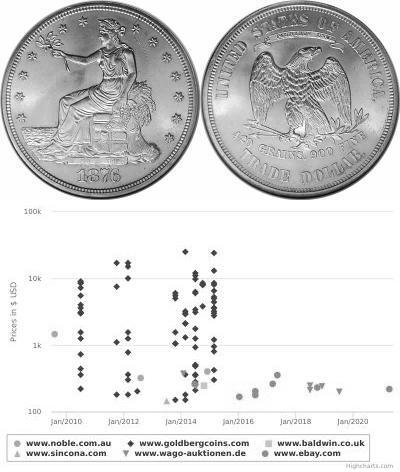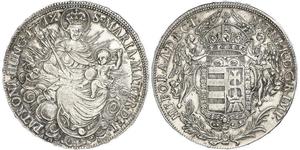1 Thaler (Vendue pour $202.0)
1690s-1750s, Kingdom of Hungary. Silver St. George Show Thaler Coin. 28.18gm!
Mint Place: Kremnitz Mint Period: ca. 1690s Reference: Huszar 12. var. R! Denomination: St. George Show Thaler (Showthaler) Condition: Lightly deformed, numerous digs and scratches, minimal corrosion spots, otherwise VF+ Weight: 28.18gm Diameter: 44mm Material: Silver
Obverse: St. George on warhorse killing the dragon. A kneeled praying figure in background to right. Legend: S:GEORGIUS EQVITUM PATRONUS Translation: "St. George Patron of Knights." Reverse: Apostles with Jesus in storm-tossed boat on Sea of Galilee. Legend: IN TEMPESTATE SECURITAS Translation: "Safety in the Tempest."
For your consideration an interesting St. George thaler (also known as showthaler, because of its medallic style) coin. This specimen was struck during the 17th century in Hungary, probably at the Kremnitz mint, imitating the gold 10 ducats masterpiece which was issued by Jeremias Roth von Rothenfels, who was die-cutter between 1690-1718. Later the the St. George thaler was re-struck under Franz Joseph for the Hungarian Millennium Anniversary, bearing the date 1896. Here we have a very handsome 17th century issue, struck in full thaler weight. A handsome specimen and a great addition!
In Christian hagiography Saint George (ca. 275-281 – April 23, 303) was a soldier of the Roman Empire, from the then Greek-speaking Anatolia, now modern day Turkey, and is venerated as a Christian martyr.
Saint George is one of the most venerated saints in the Eastern Orthodox Church and Oriental Orthodox Churches. He is immortalised in the tale of George and the Dragon and is one of the Fourteen Holy Helpers.
St. George is the patron saint of Aragon, Canada, Catalonia, China, England, Ethiopia, Georgia, Greece, Montenegro, Palestine, Portugal, Russia, and Serbia, as well as the cities of Amersfoort, Beirut, Ferrara, Freiburg, Genoa, Ljubljana, and Moscow, as well as a wide range of professions, organisations and disease sufferers.
The episode of St George and the Dragon was a legend, brought back with the Crusaders and retold with the courtly appurtenances belonging to the genre of Romance (Loomis; Whatley). The earliest known depiction of the mytheme is from early eleventh-century Cappadocia (Whately), (in the iconography of the Eastern Orthodox Church, George had been depicted as a soldier since at least the seventh century); the earliest known surviving narrative text is an eleventh-century Georgian text (Whatley).
In the fully-developed Western version, a dragon makes its nest at the spring that provides water for the city of "Silene" (perhaps modern Cyrene) in Libya or the city of Lydda, depending on the source. Consequently, the citizens have to dislodge the dragon from its nest for a time, in order to collect water. To do so, each day they offer the dragon a human sacrifice. The victim is chosen by drawing lots. One day, this happened to be the princess. The monarch begs for her life with no result. She is offered to the dragon, but there appears the saint on his travels. He faces the dragon, slays it and rescues the princess. The grateful citizens abandon their ancestral paganism and convert to Christianity.
The dragon motif was first combined with the standardized Passio Georgii in Vincent of Beauvais' encyclopedic Speculum historale and then in Jacobus de Voragine, Golden Legend, which guaranteed its popularity in the later Middle Ages as a literary and pictorial subject (Whatly).
The parallels with Perseus and Andromeda are inescapable. In the allegorical reading, the dragon embodies a suppressed pagan cult. The story has roots that predate Christianity. Examples such as Sabazios, the sky father, who was usually depicted riding on horseback, and Zeus's defeat of Typhon the Titan in Greek mythology, along with examples from Germanic and Vedic traditions, have led a number of historians, such as Loomis, to suggest that George is a Christianized version of older deities in Indo-European culture.
In the medieval romances, the lance with which St George slew the dragon was called Ascalon, named after the city of Ashkelon in Israel.
In Sweden, the princess rescued by Saint George is held to represent the kingdom of Sweden, while the dragon represents an invading army. Several sculptures of Saint George battling the dragon can be found in Stockholm, the earliest inside Storkyrkan ("The Great Church") in the Old Town.

|
Posté par:
anonymous 2021-03-10 |
|
||
|
||
|
||
1 Thaler Royaume de Hongrie (1000-1918) Argent Maria Theresa ...
Le groupe a 39 pièces / 38 prix
⇑

-600-300-YIN3fchYsUUAAAF4VTfRPBq9.jpg)

-300-150-8icKb0OMzXsAAAFC0pN7J4iq.jpg)
 English
English






-300-150-lToKbzbiL6cAAAFKciM1sT0X.jpg)






